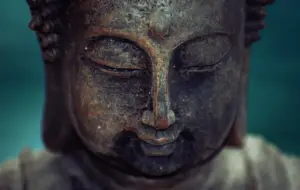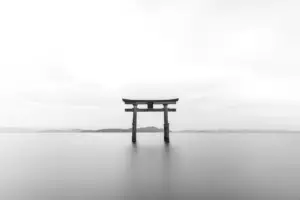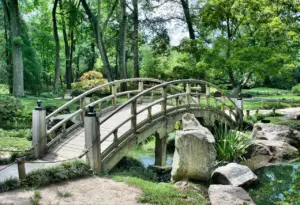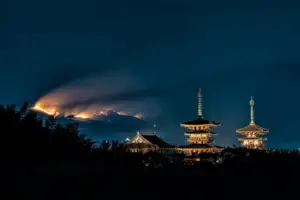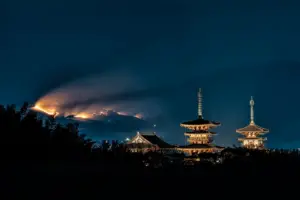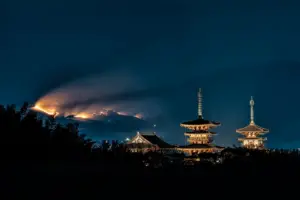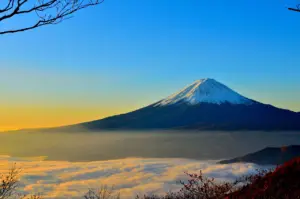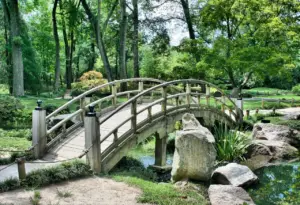Are you interested in exploring the fascinating world of Japanese religion? If so, you should delve into the syncretic tradition of Honji Suijaku, which is a unique blend of Buddhist and Shinto beliefs.
Honji Suijaku is one of several syncretic religions that have emerged in Japan, which reflect the country’s diverse cultural influences and religious traditions.
As you explore Honji Suijaku, you will discover its origins, tenets, and influence on Japanese religious culture.
You will also learn about its relevance and similarities to other syncretic religions, as well as criticisms and controversies surrounding the practice.
Whether you are a scholar of Japanese religion or simply curious about its rich history and culture, Honji Suijaku is a fascinating topic to explore.
Key Takeaways
- Honji Suijaku is a syncretic tradition that blends Buddhist and Shinto beliefs in Japan.
- Honji Suijaku reconciles Shinto and Buddhist beliefs by assigning a Shinto kami to each Buddhist deity, creating a pantheon of deities that are both Buddhist and Shinto in nature.
- Honji Suijaku has had a profound impact on Japanese religious culture, shaping beliefs and practices across the nation and promoting religious tolerance and coexistence.
- Honji Suijaku remains an essential aspect of Japan’s religious heritage but has faced criticism and controversy, with some arguing that it perpetuated gender discrimination and reinforced social inequalities.
Overview of Japan’s Religious Landscape
Japan’s religious landscape is a fascinating tapestry of traditions, beliefs, and practices. Religion in Japan is ingrained in the social and cultural fabric of the country.
Shinto is considered to be the indigenous religion of Japan and is deeply rooted in the country’s history and culture. It involves the worship of various kami or spirits, which are believed to be present in natural elements such as trees, mountains, and rivers.
Buddhism, on the other hand, was introduced to Japan from China in the 6th century and has since become an integral part of the religious landscape.
Confucianism, which emphasizes the importance of social order and harmony, was also adopted by the Japanese during the Tokugawa period (1603-1868).
In addition to these three main religions, there are also various new religious movements that have emerged in Japan over the past century, such as Soka Gakkai and Tenrikyo.
Overall, Japan’s religious landscape is a complex and diverse tapestry that reflects the unique cultural and historical influences that have shaped the country over time.
Origins of Honji Suijaku
The genesis of Honji Suijaku can be traced back to the fusion of Shinto and Buddhism in Japan. During the Nara period (710-794), Japanese imperial court officials imported Buddhism from China and Korea. At the same time, Shinto, an indigenous religion, was practiced by the Japanese people.
The two religions coexisted peacefully, and over time, a syncretic practice emerged where Shinto deities were identified with Buddhist counterparts. This practice came to be known as Honji Suijaku, which translates to ‘original ground and manifested traces.’
The term Honji Suijaku refers to the idea that the Shinto deities are the original ground (honji) and the Buddhist deities are their manifested traces (suijaku). In other words, Shinto is the foundation, and Buddhism is the manifestation of that foundation.
This syncretic practice became popular among the Japanese people and was adopted by many Buddhist temples. Honji Suijaku played a significant role in integrating Buddhism into Japanese culture and shaping the religious landscape of Japan. Today, Honji Suijaku remains an essential aspect of Japan’s religious heritage and continues to influence the country’s religious practices.
Tenets of Honji Suijaku
As you delve into the tenets of Honji Suijaku, you’ll discover a unique blend of Shintoism and Buddhism.
The primary goal of this syncretic religion is to harmonize the two belief systems by recognizing the Buddhist deities as manifestations of Shinto gods.
This reconciliation is achieved by assigning a Shinto kami to each Buddhist deity, thus creating a hierarchy of divine beings.
Reconciliation of Shintoism and Buddhism
Imagine yourself standing in front of a beautiful shrine in Japan, where you can witness the harmonious fusion of Shinto and Buddhist beliefs and practices. This is the essence of Honji Suijaku, which reconciles the two religions by regarding Shinto gods as manifestations of Buddhist deities. The term "honji"refers to the original form or nature of a deity, while "suijaku"means traces or signs. Thus, Honji Suijaku posits that the Shinto gods are suijaku or traces of the Buddhist honji.
To better understand the concept of Honji Suijaku, let us look at a table that compares the key features of Shinto and Buddhism and how they are integrated in Honji Suijaku:
| Key Features | Shinto | Buddhism | Honji Suijaku |
|---|---|---|---|
| Deity | Kami | Buddha | Kami as suijaku of Buddha honji |
| Goal | Harmony with nature and ancestors | Nirvana or liberation from suffering | Harmony with Buddha-nature in nature and ancestors |
| Rituals | Purification, offerings, festivals | Meditation, chanting, sutras | Purification, offerings, festivals, meditation, chanting, sutras |
| Sacred texts | Kojiki, Nihon Shoki, norito | Tripitaka, sutras, commentaries | Kojiki, Nihon Shoki, norito, Tripitaka, sutras, commentaries |
Honji Suijaku represents a unique approach to religious syncretism, where two distinct traditions are not merely combined but complemented and enriched by each other. It is a testament to the spiritual creativity and adaptability of the Japanese people, who have found ways to reconcile seemingly disparate beliefs and practices in a coherent and meaningful way. By exploring Honji Suijaku, we can gain a deeper appreciation of the diverse and dynamic religious landscape of Japan.
Belief in Buddhist Deities as Manifestations of Shinto Gods
Believing in Buddhist deities as manifestations of Shinto gods adds a layer of interconnectedness and spiritual significance to Japanese religious practices.
The concept of honji suijaku, which translates to ‘original ground and manifested traces,’ is what led to the syncretism of Shintoism and Buddhism in Japan. This idea suggests that Shinto gods are the original, divine beings, while Buddhist deities are manifestations or ‘traces’ of these gods.
One example of this belief is the connection between Amaterasu, the Shinto goddess of the sun, and the Buddhist deity Dainichi Nyorai, who is considered the cosmic Buddha and represents the ultimate reality of the universe.
In Japanese mythology, Amaterasu is said to be the ancestor of the Japanese imperial family, and Dainichi Nyorai is believed to have been the Buddha that granted her divine power.
This connection between the two deities further emphasizes the interconnectedness and harmony between Shintoism and Buddhism in Japan.
Influence on Japanese Religious Culture
The syncretic nature of Honji Suijaku has had a profound impact on Japanese religious culture, shaping beliefs and practices across the nation. The Japanese people have long held a belief in the interconnectedness of the spiritual realm, and Honji Suijaku has provided a framework for the merging of Buddhist and Shinto beliefs.
This has resulted in a unique religious landscape where both religions coexist in harmony, with many temples and shrines being shared by practitioners of both faiths. One of the most significant influences of Honji Suijaku on Japanese religious culture has been the development of a pantheon of deities that are both Buddhist and Shinto in nature.
These deities, known as kami-buddha, are believed to represent the interconnectedness of the two religions and are worshipped by millions of Japanese people. Additionally, Honji Suijaku has contributed to the development of various syncretic practices, such as the performance of Buddhist rituals at Shinto shrines and the incorporation of Shinto rites into Buddhist ceremonies.
Overall, the syncretic nature of Honji Suijaku has played a significant role in shaping the religious customs and beliefs of Japan, and its influence continues to be felt to this day.
Contemporary Relevance
Now that we’ve explored the influence of Honji Suijaku on Japanese religious culture, let’s turn our attention to its contemporary relevance.
Despite being a syncretic religious philosophy that emerged centuries ago, Honji Suijaku continues to play a significant role in shaping Japan’s religious landscape today. In fact, it’s argued that the syncretic nature of Honji Suijaku has helped Japanese people reconcile different religious beliefs and practices, promoting religious tolerance and coexistence.
One example of Honji Suijaku’s contemporary relevance can be seen in the popularity of new religious movements (NRMs) in Japan. Many of these NRMs draw on different religious traditions and incorporate them into their teachings, much like Honji Suijaku did centuries ago. This syncretic approach has allowed these NRMs to attract followers from different religious backgrounds and has contributed to the diversity of Japan’s religious landscape.
Furthermore, Honji Suijaku’s emphasis on the interconnectedness of different deities and religious traditions has also influenced the way Japanese people view their own religious identity. This has caused many to see it as a complex and fluid concept rather than a fixed and rigid one.
Similarities and Differences with Other Syncretic Religions
You might be surprised to learn that there are other religions besides Honji Suijaku that incorporate elements from multiple traditions, creating unique syncretic practices. One example is SanterÃa, which originated in Cuba and blends elements of Catholicism with traditional African religions. SanterÃa practitioners believe in a pantheon of deities, or Orishas, who are associated with different aspects of nature and human life. They also incorporate Catholic saints into their worship and rituals.
Another syncretic religion is Vodou, which is practiced in Haiti and other parts of the Caribbean. Vodou is a fusion of traditional African religions and Catholicism, similar to SanterÃa. It also includes elements of Native American spirituality and European occultism. Vodou practitioners believe in a pantheon of spirits, or Lwa, who are associated with different aspects of life, such as love, fertility, and death. They also incorporate Catholic saints into their worship and rituals, and believe that the Lwa can possess human beings during religious ceremonies.
Despite these similarities, Honji Suijaku is unique in its blending of Shinto and Buddhist traditions. Its syncretism is not just a matter of incorporating elements from two different religions, but of seeing them as complementary and mutually reinforcing. Honji Suijaku emphasizes the idea that the kami of Shinto are manifestations of the Buddha-nature, and that the Buddha and the kami are ultimately one and the same.
This philosophical synthesis is what sets Honji Suijaku apart from other syncretic religions and makes it a fascinating subject of study.
Criticisms and Controversies
As you delve into the topic of Honji Suijaku, it’s important to also consider some of the criticisms and controversies that have arisen surrounding this syncretic religion.
Some scholars have argued that the blending of Shinto and Buddhism in Honji Suijaku was a result of political and social pressures, rather than genuine religious syncretism.
Others have criticized the hierarchy and power dynamics within Honji Suijaku institutions, with some arguing that it has perpetuated gender discrimination and reinforced social inequalities.
Despite these criticisms, Honji Suijaku remains a significant and fascinating aspect of Japanese religious culture, showcasing the complex and dynamic nature of religious syncretism.
Summary of Key Points
Honji suijaku is a syncretic religious concept in Japan that combines indigenous beliefs with Buddhist and Shinto practices. This belief system has some key points that you should take note of:
-
Honji suijaku translates to ‘original ground and trace manifestations’ and suggests that the deities from Shintoism are manifestations of Buddhist principles.
-
The concept is rooted in the idea that Buddhism and Shintoism are not mutually exclusive, and that they can complement each other.
-
Honji suijaku became popular during the Kamakura period in Japan, when Buddhist monks started incorporating indigenous beliefs into their practices.
-
Some scholars believe that this religious hybrid was created to help unify Japan under a common belief system during a time of political instability.
Despite its popularity, Honji suijaku has faced criticism and controversy. However, understanding the key points of this concept can help us appreciate the unique religious landscape of Japan and how it has been shaped by centuries of cultural exchange and syncretism.
Reflection on the Significance of Honji Suijaku in Japanese Religious Culture
Now that you have gained a better understanding of the key points surrounding the concept of Honji Suijaku, let’s delve deeper into its significance in Japanese religious culture. The term Honji Suijaku refers to the practice of blending indigenous Japanese beliefs with imported Buddhist and Confucian ideas. This syncretic religion played a crucial role in shaping the religious landscape of Japan and continues to influence modern Japanese religious practices.
To fully comprehend the significance of Honji Suijaku, it is important to understand the cultural context in which it emerged. During the Heian period, Japan was experiencing a period of cultural flourishing that saw the rise of new art forms, literature, and religious practices. This period was characterized by the emergence of a new elite class that was heavily influenced by Chinese culture and Confucianism. It was during this time that the practice of Honji Suijaku emerged as a way of reconciling indigenous Japanese beliefs with the imported Confucian and Buddhist ideas. The table below highlights some of the key beliefs and practices that emerged from this syncretic religion.
| Beliefs | Practices |
|---|---|
| Japanese gods (kami) have a divine nature that is equivalent to that of Buddha | Shinto and Buddhist rituals were combined |
| Buddha and bodhisattvas were believed to be manifestations of Japanese gods | Buddhist temples were built on Shinto shrines |
| Confucian ideals of filial piety and loyalty were incorporated into religious practices | Confucian texts were translated into Japanese and used for religious teachings |
The integration of these beliefs and practices not only helped to reconcile different religious traditions but also facilitated the creation of a shared cultural identity among the Japanese people. The significance of Honji Suijaku in Japanese religious culture cannot be overstated, as it continues to shape the way in which Japanese people view and practice religion today.
Frequently Asked Questions
How does Honji Suijaku compare to other syncretic religions around the world?
When comparing Honji Suijaku to other syncretic religions around the world, it’s important to note that syncretism itself is a common phenomenon in many cultures.
Syncretic religions often emerge as a result of cultural contact and the blending of different religious traditions.
However, the specific characteristics of Honji Suijaku, such as the concept of honji and the use of kami as a means of expressing Buddhist teachings, make it unique to Japan.
While other syncretic religions may share some similarities with Honji Suijaku, such as the incorporation of elements from multiple religions, the specific ways in which these elements are combined and expressed are distinct to each individual syncretic religion.
Therefore, it’s important to approach each syncretic religion on its own terms and examine the specific cultural and historical factors that have contributed to its development.
Are there any specific rituals or practices associated with Honji Suijaku?
When it comes to specific rituals or practices associated with Honji Suijaku, there are a few notable ones.
For instance, Honji Suijaku emphasizes the importance of purification, so many of its adherents engage in various forms of purification rituals.
Additionally, many followers of Honji Suijaku engage in ancestor worship, with the belief that their ancestors can help guide and protect them.
Another common practice is the use of talismans and amulets, which are believed to offer protection and good fortune.
Finally, Honji Suijaku also places importance on meditation and contemplation, with many followers engaging in daily meditation practices to deepen their spiritual connection.
Overall, while there aren’t any specific dogmatic practices associated with Honji Suijaku, it’s a religion that emphasizes personal spiritual exploration and connection.
How has Honji Suijaku evolved over time?
Honji suijaku, the Japanese concept of ‘original reality and manifested traces,’ has evolved over time through a process of syncretism, adaptation, and reinterpretation.
This syncretic religious practice emerged during the Heian period (794-1185) and has since incorporated elements from various religious traditions, including Shinto, Buddhism, Taoism, Confucianism, and folk beliefs.
Honji suijaku has also undergone significant changes in response to historical and social contexts, such as the Meiji Restoration (1868-1912) and the post-World War II period.
For example, during the Meiji period, the government promoted Shinto as the national religion, leading to the separation of Shinto and Buddhism and the suppression of Buddhist practices. In contrast, after World War II, there was a resurgence of interest in Buddhism and a rejection of the state-sponsored Shinto.
Today, honji suijaku continues to evolve as a dynamic and complex religious practice that reflects the diverse cultural, historical, and social influences of Japan.
What role do non-Japanese people play in Honji Suijaku?
Non-Japanese people don’t have a significant role in honji suijaku, a syncretic religious practice in Japan that blends Shinto and Buddhist beliefs.
Honji suijaku centers on the concept of honji, referring to the original nature of Japanese gods, and suijaku, referring to Buddhist deities taking on the forms of Japanese gods.
While honji suijaku influenced some Western thinkers like Carl Jung, it is a uniquely Japanese religious practice that is deeply tied to Japanese culture and history.
Therefore, non-Japanese people typically aren’t involved in the rituals, traditions, or beliefs associated with honji suijaku.
Are there any current debates or controversies surrounding Honji Suijaku in Japan?
In Japan, there are ongoing debates and controversies surrounding Honji Suijaku, a syncretic religious concept that emerged during the Heian period. Some scholars argue that Honji Suijaku has been used to justify discrimination against certain religious groups, such as the Burakumin, who historically have been considered ‘impure.’
Others argue that Honji Suijaku has been misinterpreted and that its original meaning was not discriminatory. Additionally, there is debate over whether Honji Suijaku is still relevant in modern-day Japan, as many Japanese people have moved away from traditional religious practices.
Despite these debates and controversies, Honji Suijaku remains an important aspect of Japan’s religious and cultural history.
Conclusion
In conclusion, exploring Japan’s syncretic religions can reveal a unique and complex religious landscape. Honji Suijaku, as one of the most prominent syncretic religions in Japan, is a prime example of how Japanese culture has blended different religious traditions over time. Its origins, tenets, and influence on Japanese religious culture showcase the adaptability and fluidity of religion in Japan.
However, despite its popularity, Honji Suijaku is not without criticisms and controversies. Some argue that its syncretic nature dilutes the authenticity of both Shinto and Buddhism, while others view it as a form of cultural appropriation.
Nevertheless, Honji Suijaku remains a significant aspect of Japan’s religious heritage and continues to shape contemporary religious practices in the country. Understanding its complexities and nuances can deepen one’s appreciation for Japan’s rich religious history and cultural identity.











